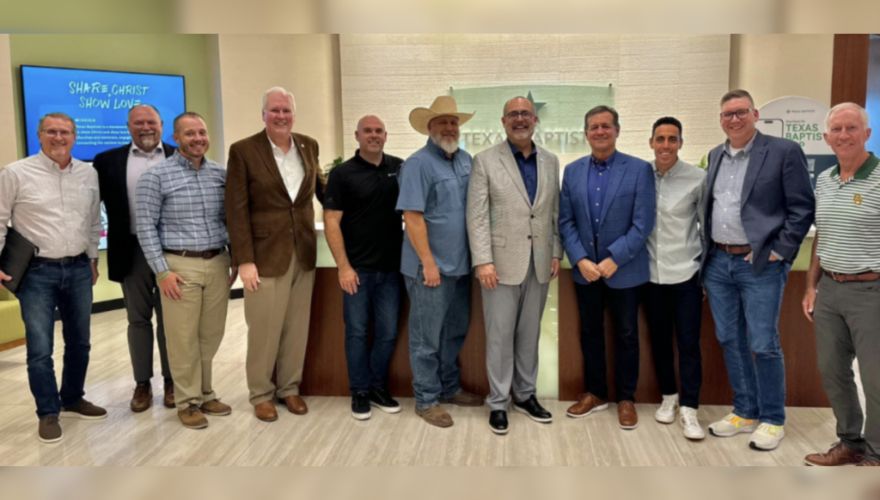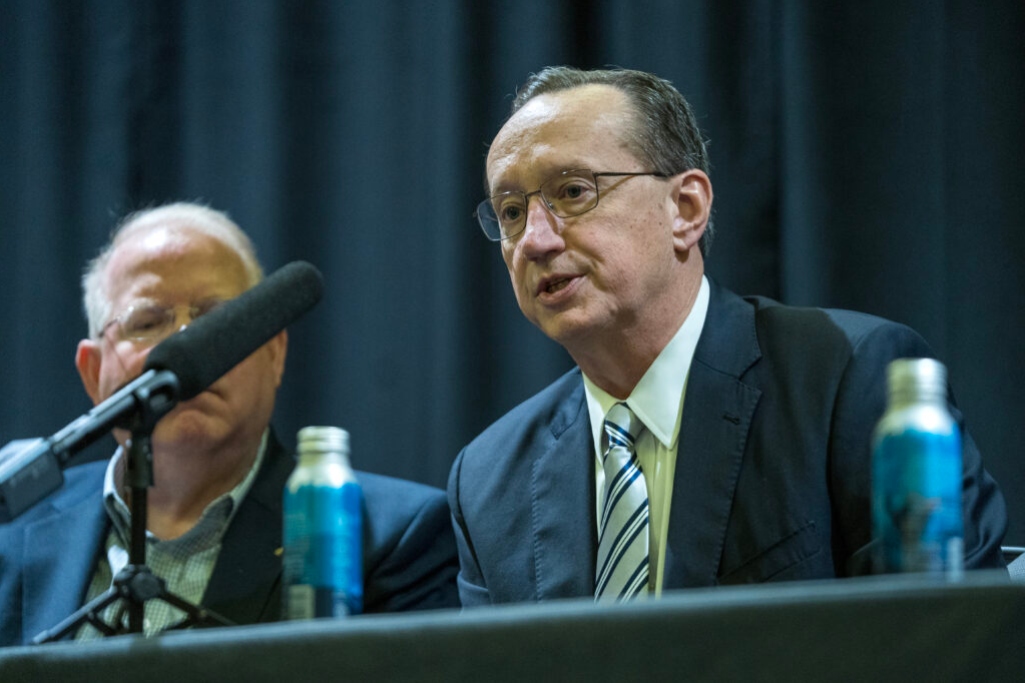
(Left to right) Rusty Shuler, NAMB church relations mobilizer; Ward Hayes, BGCT Treasurer/CFO; Dan Newburg, pastor First Baptist Church in Devine; Craig Christina, BGCT associate executive director; Dustin Slaton, pastor of First Baptist Church in Round Rock; Pete Pawelek, pastor of Cowboy Fellowship in Jourdanton; Julio Guarneri, BGCT executive director; Kevin Ezell, president of NAMB; Bobby Contreras, BGCT executive board chair; Chad Edgington, pastor of First Baptist Church in Olney; and Jeff Williams, pastor of First Baptist Church in Denton.
DALLAS (BP) — Baptist General Convention of Texas (BGCT) and North American Mission Board (NAMB) representatives met at the BGCT offices Aug. 15.
The meeting was a follow-up on the exchange between, Dustin Slaton, senior pastor of First Baptist Church Round Rock, Texas, and NAMB President Kevin Ezell at the Southern Baptist Convention (SBC) annual meeting in Indianapolis.
At that June meeting, Slaton posed a question from the floor to Ezell regarding BGCT churches’ ability to access grant money NAMB disperses to Texas for church planting and evangelism.
In his answer, Ezell expressed a willingness to discuss the relationship between NAMB and the BGCT, while also stating an unwillingness to deviate from NAMB’s longstanding commitment to partner only with those state conventions that affirm the Baptist Faith and Message 2000.
BGCT pastors who attended the meeting between the two entities included Slaton; Chad Edgington, pastor of First Baptist Church in Olney; Pete Pawelek, senior pastor of Cowboy Fellowship in Jourdanton; and Jeff Williams, senior pastor of First Baptist Church in Denton — who are also current BGCT Executive Board directors — as well as Dan Newburg, senior pastor of First Baptist Church in Devine.
BGCT Executive Director Julio Guarneri, Associate Executive Director Craig Christina and Treasurer/Chief Financial Officer Ward Hayes also participated, along with BGCT Executive Board Chair Bobby Contreras, pastor of Alamo Heights Baptist Church in San Antonio.
Ezell and Rusty Shuler, church relations mobilizer, represented the North American Mission Board. Williams, while not an official liaison, holds leadership roles with the BGCT and NAMB until he concludes BGCT executive board trustee duties in a few months.
Guarneri stated he “genuinely appreciate(s) Kevin’s willingness to come this way and meet with a handful of our Texas Baptists pastors, some of whom also serve with our BGCT Executive Board.
“These pastors have such a strong heart and passion for seeing God’s kingdom advanced in Texas and beyond. I am grateful for their time and attention in this matter. As I’ve said before, there is too much lostness for any one group to think they can do it alone. We all know we are better when we work and minister together.
“I look forward to the continuation of this dialogue as we seek to fill in the gaps and resource our Texas Baptists churches to live out the Great Commission.”
Ezell confirmed that the meeting grew out of Slaton’s question to him at the annual meeting.
“We talked by phone a few times and planned to get together in person and then more pastors wanted to join in,” Ezell said in an email. “I appreciated Julio hosting us and being able to spend time with him and the pastors. We are grateful for the generosity of BGCT churches and look forward to continuing to serve them and partner with them.”
Slaton echoed that sense of collegiality, saying: “The conversation between those in the room was honest, cordial and hopeful for a good relationship between the BGCT and NAMB.”
Slaton said when he asked his question at the annual meeting, he hoped to initiate a dialogue that would improve the partnership between the BGCT and NAMB.
“Thursday’s conversation was a great step in that direction,” he said, adding he was “encouraged to find that BGCT churches do have access to NAMB resources, training, personnel and assistance through the church planting process.”
“Basically, aside from funding,” he continued, “we have access to anything anyone else has access to, and the funding can possibly come through the $300,000 NAMB grants to the BGCT, annually.”
He said the meeting gave him hope that “we may find ways in the future to see an increase in funding to the BGCT through a re-evaluation of the process.”
Slaton hopes BGCT churches hear they have access to church planting tools and guidance from both BGCT and NAMB, should they wish to utilize either or both organizations’ resources.
In a statement to Baptist Press, a NAMB spokesperson said that for southern states that prefer to use their own church planting process rather than Send Network, NAMB can still help.
“NAMB is still involved by providing an annual grant of $300,000 which can be used for evangelism, church planting or church revitalization,” the statement said. “It is NAMB’s desire that BGCT churches also be able to access those funds for church planting and that is what the ongoing discussions are about.”
Edgington credits Pawelek with connecting all the parties to ensure the meeting suggested in the Indianapolis exchange actually came to pass.
Pawelek demurred, deferring it instead to NAMB and BGCT leaders who made time to come together with concerned pastors. He wanted the meeting to “get some clarity” and make sure the history of cooperation between NAMB and BGCT continues, he said.
Edgington said everybody in the meeting was kind, and they heard and cleared up misconceptions about the relationship between NAMB and the BGCT, which is complicated by differing statements of faith.
Edgington said Ezell came to listen to the BGCT side, and it was good to hear everything “from the horses’ mouths” on both sides, in an atmosphere of cooperation.
He noted the tendency in Baptist life for the things that get “drummed up” to distract from recognizing what Baptists have in common.
“Sometimes it’s good to realize that we’re all on the same team,” he continued. “And that there’s massive agreement and a real desire to plant churches and reach people for the gospel on both sides.”
Williams noted in his role as pastor ambassador for NAMB, he’d had questions come his way from pastors about the relationship between NAMB and the BGCT.
So he welcomed the opportunity the meeting provided to allay misconceptions about boundaries to cooperation between the two organizations.
Slaton said he expressed appreciation to both Guarneri and Ezell for firmly but graciously stating the positions and concerns of their respective organizations.
He did not sense pressure to achieve certain changes from either of the represented organizations, saying: “If every issue between differing views and different groups was handled as well as this meeting, the SBC would be a much better environment. I was proud of both the BGCT and NAMB.”
As the intent of the meeting was dialogue, no actions were taken, and no further conversations have been scheduled, though the pastors and organizational leaders expressed hope dialogue will continue.
(EDITOR’S NOTE — This article originally appeared in the Baptist Standard.)


